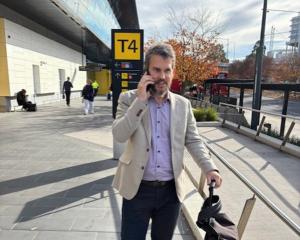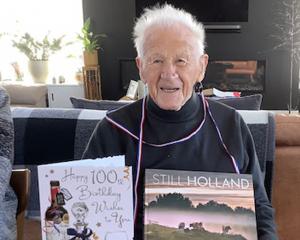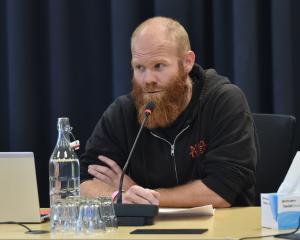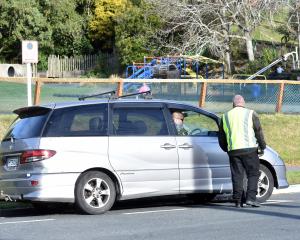
The new shared path to Port Chalmers creates a potential urban tramp.
The "hut" would have a hot shower, a meal with fresh vegetables and all bedding provided. After waking up to the luxury of being grossed out by your own snoring and yours only, there’s a half-day walk with no pack.

It starts at what feels like a private garden at the base of a cliff.
As recently as the 1960s it was a local tip but in its overgrown 1990s was rescued by former Mayoress of Port Chalmers, Constance Lady Thorn. Local Lions went hard and today’s Lady Thorn Rhododendron Dell is now publicly accessible and a little cutie.
The site itself tells a very Port Chalmers story of hard physical work. The cliff is the carved-out remnant of a quarry that gave rock from 1866 to the 1920s. Early quarrymen and stonemasons worked with horse and cart and we still reap the benefits in solid bluestone buildings throughout Port Chalmers and Dunedin.
The bare quarry wall must seem enticing from a ship docked in port - for the next 50 years it became a blank canvas for visiting sailors to climb and sign. So tagging’s not new but the fashion then was to sign your ship’s name, not your own.
Koputai Bay retains its original name. Now it’s covered by the port structure but way back had a forested coastline. The story goes that one night a particularly high tide crept up and carried beached waka out into the harbour. In the morning, the sleeping canoeists woke up, discovered what had happened and named the area Koputai in reference to the swollen (kopu) tide (tai).
The New Port Chalmers Cemetery is close by. "New" hints at the length of Pākehā settlement as the cemetery includes graves of my great-great-grandparents. The cemetery looks straight up the harbour from a sunny slope, like a Waverley with an even better view. How neat it’s been bagsed for the public.
It’s still in active use but less so these days. If the popularity of scattering ashes continues, maybe our cemeteries eventually become a quaint anachronism, recording a period of a few hundred years. How grounding though, to be able to visit an ancestor’s remains - solid, earthed and connected.

The lookout itself is also a celebration of human cleverness, commemorating the first cargo of frozen meat to leave New Zealand. It happened here in 1882.
Pukekura-Taiaroa Head, the treasured base for Māori tipuna, is visible, as is the arrival zone at Port Chalmers of early Pākehā tipuna. Immigration rates are high again, with about 30% of modern New Zealanders having been born overseas. The rest all whakapapa to immigrants and gorgeous views like today’s elicit a big "thank you" for the bravery that resulted in our privilege.
A bushy track across the road leads to an even older cemetery. Pulling a full Wuthering Heights, it’s camouflaged by heavy conifers but is just a stone’s throw from town.
Soon the maritime museum is opening after a revamp. They have kept the public viewing area with its lazy industrial inspector’s close-up view of ships being loaded and unloaded. Along with the admiration, there’s a secret schadenfreude in spying on someone else’s work. There’s also a "thank goodness" for modern technology and safe backs.
Back Beach is on a gravel road at the base of the small peninsula. The speed limit’s a tranquil 30kmh but with blue and green views across the harbour everyone’s already in Sunday drive mode. Specklings of roadside poetry and art encourage more cruisiness.
Tempting tracks dart up the hill. Those at the port end go up to Flagstaff Lookout at Observation Point. The tip of this headland was removed in the early 1990s to make way for port expansion, necessitating demolition of the studio of artist Ralph Hotere, along with removal of large outdoor sculptures.
Artworks have been back on site since 2005, part of an award-winning garden. They’re not all Ralph Hotere’s work and anyway, it might be tempting fate to display his valuable art unguarded. The one Hotere piece is fenced and is also made out of a huge chunk of burnt-out fishing boat so should be right.
Port Chalmers’ streets were once walked by a future saint. When she arrived in 1898 she wasn’t yet a saint but was unintentionally working on it. In her mid-fifties, she was a livewire still dedicating her life to service.
Mary MacKillop’s visit was to re-establish the struggling Catholic school, St Mary’s. The school used a shed-like house, old and cold, beside the church still in existence in Magnetic St.
Only a few weeks later the school building had been made-over and was reopened as St Joseph’s school. Until its closure in January this year, a modernised St Joseph’s school still operated on the same site as Mother Mary worked.
Mary MacKillop’s career included founding an order of nuns, The Sisters of St Joseph. She also established brand new schools for poor children. She was even excommunicated from the Church, exonerated by a bishop on his deathbed then eventually, in 2010, canonised a saint. What a life. St Mary MacKillop was Australian. But she worked throughout Australasia, so to make up for the pavlova, let’s call her ours.
At the bottom of Laing St there’s a track down to Mussel Bay, near the bus stop back to town.












